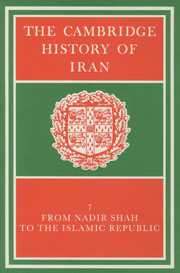Book contents
- Frontmatter
- PART 1 THE POLITICAL FRAMEWORK, 1722–1979
- 1 NĀDIR SHĀH AND THE AFSHARID LEGACY
- 2 THE ZAND DYNASTY
- 3 ĀGHĀ MUHAMMAD KHĀN AND THE ESTABLISHMENT OF THE QĀJĀR DYNASTY
- 4 IRAN DURING THE REIGNS OF FATH ‘Alī SHāH AND MUHAMMAD SHāH
- 5 IRAN UNDER THE LATER QĀJĀRS, 1848–1922
- 6 THE PAHLAVĪ AUTOCRACY: RIŻĀ SHĀH, 1921–41
- 7 THE PAHLAVĪ AUTOCRACY: MUHAMMAD RIŻĀ SHĀH, 1941–1979
- PART 2 FOREIGN RELATIONS
- PART 3 ECONOMIC AND SOCIAL DEVELOPMENTS
- PART 4 RELIGIOUS AND CULTURAL LIFE, 1721–1979
- Genealogical tables
- Bibliographies
- Index
- References
5 - IRAN UNDER THE LATER QĀJĀRS, 1848–1922
from PART 1 - THE POLITICAL FRAMEWORK, 1722–1979
Published online by Cambridge University Press: 28 March 2008
- Frontmatter
- PART 1 THE POLITICAL FRAMEWORK, 1722–1979
- 1 NĀDIR SHĀH AND THE AFSHARID LEGACY
- 2 THE ZAND DYNASTY
- 3 ĀGHĀ MUHAMMAD KHĀN AND THE ESTABLISHMENT OF THE QĀJĀR DYNASTY
- 4 IRAN DURING THE REIGNS OF FATH ‘Alī SHāH AND MUHAMMAD SHāH
- 5 IRAN UNDER THE LATER QĀJĀRS, 1848–1922
- 6 THE PAHLAVĪ AUTOCRACY: RIŻĀ SHĀH, 1921–41
- 7 THE PAHLAVĪ AUTOCRACY: MUHAMMAD RIŻĀ SHĀH, 1941–1979
- PART 2 FOREIGN RELATIONS
- PART 3 ECONOMIC AND SOCIAL DEVELOPMENTS
- PART 4 RELIGIOUS AND CULTURAL LIFE, 1721–1979
- Genealogical tables
- Bibliographies
- Index
- References
Summary
THE QāJāR POLITICAL SYSTEM
Before discussing the vicissitudes of late Qājār politics, it would be useful to try to understand how 19th century Iranian politics worked. Essentially these workings were only a slight variation on the general pattern of Iranian politics since the 11th century, when large-scale invasions of nomadic Turkish tribes that accompanied the Saljuq incursions, and the spread of the quasi-feudal iqtā‘ system strengthened the regional power of tribal and other military leaders and weakened the strength of central governments. Although there were, between the 11th and 19th centuries, governments of very varied powers, ranging from the strongest of the Saljuq, Mongol and Safavid rulers to periods of complete breakdown of central government, there were certain similarities that characterize the whole of this period. Among these was the status of the numerous nomadic tribes, which ranged from almost total independence to a degree of internal autonomy. Tribes managed not only their own internal affairs, subject generally to tribute and pro-forma confirmation of tribal leaders by the rulers, but also frequently ruled over villagers who inhabited territories in their regions. Beyond this internal autonomy, the tribes constituted the most effective fighting forces in Iran during most of this long period - their mastery of horsemanship and of the latest weapons giving them a decisive advantage over the city population, whom the Shahs generally showed little inclination to train. Every important Iranian dynasty from the Saljuqs to the Qājārs was either tribal in origin or relied on tribal backing in taking power. In the early 19th century, nomadic tribes were estimated to form one third to one half of the Iranian population.
- Type
- Chapter
- Information
- The Cambridge History of Iran , pp. 174 - 212Publisher: Cambridge University PressPrint publication year: 1991
References
- 24
- Cited by

